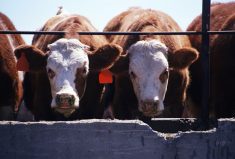Thin volumes characterized last week’s feeder cattle market, with most action markets in summer holiday mode. Western Canadian prices were led lower by the U.S. market, which was under severe pressure due to stronger corn prices.
Record temperatures were recorded in over 250 U.S. cities last week and the forecast calls for above-normal temperatures and below-normal precipitation for the next 10 days. A large portion of the corn will move through the pollination stage during this time and yields are expected to be similar or below last year. There is potential for corn fundamentals to be historically tight for the third year in a row, given the drought-like conditions.
Read Also

U.S. grains: Soybeans mixed on doubts over Chinese demand
U.S. soybean futures were mixed at Friday’s close at the end of a see-saw week during which Chinese purchases of U.S. supplies pushed prices to a 17-month high before doubts about whether China would sustain such buying punctured the rally.
Canadian export feed barley offers are now higher than the domestic market for September and October. There is potential for a large export program during the fall period, which could drain western Canadian supplies and cause barley prices to surge. We may see some harvest pressure on the barley market but next spring, the market needs to ration demand by trading at a premium to the world market. This will temper the upside for feeder cattle prices.
In comparison to week-ago levels, U.S. feeder cattle under 650 pounds were $10-$15 per hundredweight (cwt) lower on average; in drier regions, prices were down as much as $20/cwt. U.S. feeder cattle are being placed earlier than usual in certain areas, which will cause beef production to be larger than expected in the fourth quarter. Western Canadian feeder prices were down $5-$6/cwt on very light trade.
Alberta packers bought fed cattle in the range of $109-$110/cwt as wholesale prices remain rather strong for this time of year. Feedlots are moving through a massive liquidation phase of fed cattle but uncertain feedgrain costs have limited demand for replacements. Secondly, grass conditions are favourable across Western Canada, limiting feeder cattle availability.
Feeder cattle prices are difficult to forecast given the feedgrain price uncertainty. We need to see fed cattle prices rally in order to turn this feeder market higher.
— Jerry Klassen is a commodity market analyst in Winnipeg and maintains an interest in the family feedlot in southern Alberta. He writes an in-depth biweekly commentary, Canadian Feedlot and Cattle Market Analysis, for feedlot operators in Canada. He can be reached by email at [email protected] for questions or comments.















